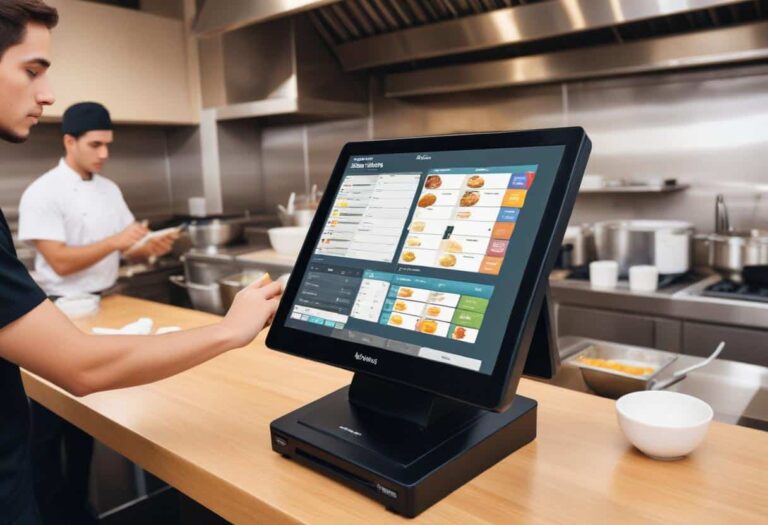In the restaurant industry, efficiency is paramount. Every second saved contributes not only to customer satisfaction but also to your overall profitability. This is where a cutting-edge POS System (POS) becomes indispensable. Think of it as your strategic advantage for achieving excellence. A contemporary electronic POS (EPOS) system transcends the functionality of a mere cash register; it’s an integrated tool designed to enhance every facet of your restaurant’s operations–from ensuring order accuracy and fostering customer loyalty to boosting profit margins. But how does it accomplish all this? And how can you leverage your POS system to elevate your restaurant’s performance? Let’s delve into the details.
### Understanding Your POS System
A restaurant POS system, or point-of-sale, acts as the operational backbone of any dining establishment. It integrates both hardware and software elements to streamline transactions and simplify essential daily business activities, particularly in retail or restaurant environments. Serving as a central hub, it processes and stores vital information related to orders, payments, and employee management while offering crucial insights for effective restaurant management.

### Components
A POS system comprises two primary components: hardware and software.
– **Hardware:** This includes intuitive terminals or tablets equipped with high-resolution touchscreens for seamless order-taking. Additional features may include a magnetic stripe reader for credit card transactions, a barcode scanner for quick product pricing, and an internal receipt printer that generates bills on the spot. Some systems also incorporate a kitchen display system (KDS), which provides real-time order updates directly to kitchen staff.
– **Software:** The software component is equally critical, offering functionalities that range from inventory management and sales tracking to customer relationship management (CRM) tools. Moreover, advanced POS systems may feature supplementary hardware such as digital menus and promotional displays that further enhance customer engagement. By understanding these components and their functionalities, you can fully harness the power of your POS system to drive superior performance in your restaurant business.
Core Responsibilities
At its foundation, a POS system is tasked with the following key functions:
Order Processing: Efficient and precise order acceptance. This entails allowing staff to select menu items from the terminal, choose modifiers and variations, and handle special customer requests. Upon confirmation, the POS system sends the order directly to the kitchen, reducing errors and boosting efficiency.
Payment Processing: Catering to diverse customer payment preferences requires various payment gateways. Contemporary POS systems accommodate an extensive array of payment methods: cash, credit or debit cards, contactless mobile wallet payments, and even split bills for groups.
Enhancing Restaurant Performance with a POS System
Optimizing Order Management.
Order Accuracy: One of the most significant benefits of a POS system is its capacity to eliminate errors in order-taking. With an intuitive interface, servers can quickly select menu items, address special requests and dietary needs, and send orders directly to the kitchen. This minimizes errors and miscommunication between front-of-house and back-of-house staff, resulting in fewer mistakes, higher customer satisfaction, and reduced food waste.
Speed of Service: By automating the entire order processing workflow–sending orders straight to the kitchen and prioritizing them based on preparation times–a POS system enables chefs to focus more on cooking rather than organizing tasks. This feature enhances kitchen efficiency and improves table turnover rates.
Table Management: Modern POS systems often include robust table management functionalities that enable your staff to allocate and monitor tables in real-time. This capability ensures that tables are promptly cleared and turned over, thereby maximizing your seating capacity and minimizing customer wait times.
Enhancing Customer Experience: A sophisticated restaurant POS system significantly improves the customer experience by empowering staff to deliver a more personalized and seamless dining service.
Personalization: Your POS system is an invaluable resource for collecting data to offer tailored services to each customer. It enables staff to greet regular patrons by name, recall their usual orders, and recommend new dishes based on their preferences. This personal touch not only enhances the dining experience but also fosters customer loyalty and repeat business.
Loyalty Programs: The POS system can be leveraged to implement effective loyalty programs. By tracking customer purchases, the system allows you to reward loyal customers with discounts, special offers, or exclusive perks. This strategy encourages repeat visits and helps build a dedicated customer base.
Feedback Collection: Your POS system is also instrumental in gathering and analyzing customer feedback. By integrating surveys or other feedback mechanisms, you can collect valuable insights about your customers’ experiences. This information is crucial for identifying areas that need improvement and customizing your services to better meet your customers’ needs.
Efficient Inventory Management for Restaurants
Effective inventory management is crucial for the smooth operation of your restaurant.
Real-Time Monitoring: The POS system provides instant visibility into your inventory status. By closely monitoring ingredient consumption and stock levels, you can identify items that are running low before they deplete completely. Additionally, the system helps you track expiration dates to guarantee that all food served is fresh. This technology also allows for detailed analysis of inventory costs, helping you pinpoint areas where cost savings can be achieved through optimization.
Automatic Reordering: Implement automatic reordering for frequently used ingredients. Modern POS systems can detect usage patterns and automatically generate purchase orders when stock reaches a predetermined threshold. This feature mitigates the risk of stockouts and streamlines the restocking process.
Waste Minimization: Improved inventory management significantly reduces food waste. By controlling ordering processes and meticulously tracking ingredient usage, you can avoid overstocking and spoilage, leading to substantial cost savings and more sustainable business practices.
Employee Management
Leveraging a POS system can significantly enhance workforce efficiency and empowerment.
Scheduling & Time Tracking: Streamline shift management, break periods, and time-off requests through your POS system. This approach reduces miscommunication, saves valuable time, and optimizes workforce management.
Performance Monitoring: Utilize your POS system to monitor essential performance metrics such as sales generation, order accuracy, and service speed. This data offers actionable insights for providing constructive feedback and coaching to help staff refine their skills.
Training & Accountability: Replace manual training with integrated training modules and tutorials within your POS system to effectively onboard new employees. Track individual logins, working hours, and actions to foster accountability and facilitate performance tracking.

Sales & Revenue Tracking
A POS system can provide the essential data needed for this purpose.
Sales Reports: Generate comprehensive sales reports from your POS system to gain valuable insights into revenue streams, top-selling items, and overall performance. These insights enable data-driven decisions regarding menu offerings, pricing strategies, and promotional activities.
Identifying Trends: Over time, data from your POS system can uncover trends such as peak operating hours, popular menu items, and seasonal fluctuations. Use this information to optimize staffing schedules, manage inventory more effectively, and tailor marketing efforts accordingly.
Profit Margins: Detailed sales and cost data are critical for monitoring and improving profit margins. This information helps identify opportunities for cost reduction or price adjustments to maximize profitability.
Power Up Your Business with Secure, Affordable,
and Efficient Payment Solutions
Marketing & Promotions
Your POS system can be a powerful marketing tool thanks to the following features.
Targeted Campaigns: Many of the latest POS systems come with tools to support your marketing efforts, such as tools to help you plan, create, and track promotions, coupons, or special offers.
Targeted Offers: By gaining access to customer data (courtesy of your Point of sale system), you can deliver laser-focused promotions and deals specific to demographics, boosting the efficiency of your marketing efforts.
Social Media Integration: Many POS systems will allow you to integrate natively with social media so that your promotions, contests, and campaigns can be executed on these platforms directly through your POS system.
Data Security & Compliance
A restaurant’s critical responsibility is keeping customer data secure and ensuring compliance with industry standards.
Security Features: Most modern POS systems have encryption and tokenization to safeguard sensitive customer enforcement and ensure compliance with standards like the Payment Card Industry Data Security Standard (PCI DSS).
Compliance: A POS system can protect your business assets and assist with ensuring compliance with various rules and regulations, such as food safety and labor laws.
Integrations with Other Restaurant Tech Systems
Most POS systems offer integrations with other business systems to ensure operational cohesiveness.
Inventory management systems: Lavu is an end-to-end inventory solution that uses data from your POS to provide insights into sales, food costs, menu engineering and inventory management.
Accounting Software: Linking your POS to your accounting software can simplify financial approaches by automatically extracting sales and cost data, enabling faster reconciliation.
Online Ordering& Delivery: If your restaurant delivers or offers online ordering, POS system integration will make order management more manageable and reduce the risk of manual entry mistakes.
Customer Relationship Management (CRM): Integrating your POS with the CRM system will enrich your customer database, helping you create highly targeted marketing campaigns and optimize your services per customer demand.
Choosing the Right POS System
With so many options available, selecting the right POS system is crucial.
Needs Assessment: Before selecting a system, conduct a comprehensive needs assessment, considering the size of your operation, the types of services offered, and any specific industry requirements you may have to meet.
Feature Comparison: Conduct due diligence to assess and compare different POS systems ‘attributes, such as features, scalability, and pricing model, so they are in line with your requirements now and in the future.
Vendor Support & Training: Beyond the overall features and price, evaluate the vendor’s level of support and training. Reliable support and full end-user training are likely necessary to achieve uninterrupted usage and long-term value.
Working with United Banc Card of TN
If you find yourself wanting to conquer your restaurant, retail shop, look no further thanUnited Banc Card of TN. With their innovative solutions and trustedPOS System services, they will guide you towards financial success. Whether you are asmall business owneror an individual looking to manage your finances better, United Banc Card of TN has the tools and expertise to help. Call us today @615-476-0255


